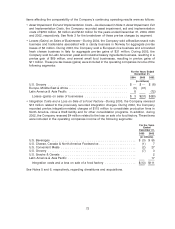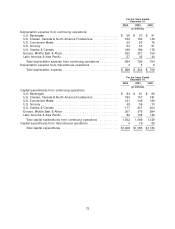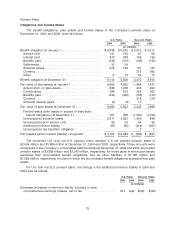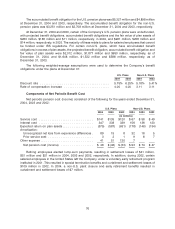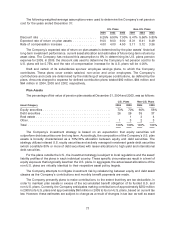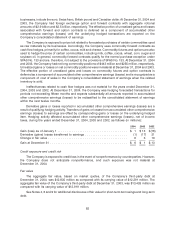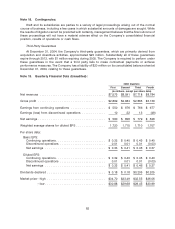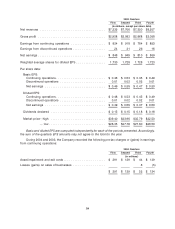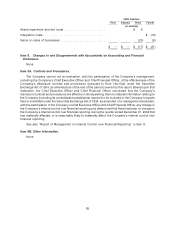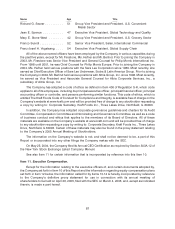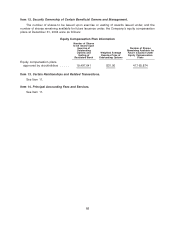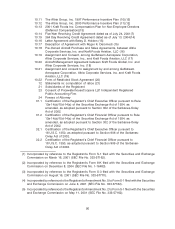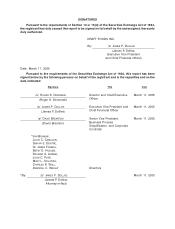Kraft 2004 Annual Report Download - page 83
Download and view the complete annual report
Please find page 83 of the 2004 Kraft annual report below. You can navigate through the pages in the report by either clicking on the pages listed below, or by using the keyword search tool below to find specific information within the annual report.
businesses, include the euro, Swiss franc, British pound and Canadian dollar. At December 31, 2004 and
2003, the Company had foreign exchange option and forward contracts with aggregate notional
amounts of $2.9 billion and $2.5 billion, respectively. The effective portion of unrealized gains and losses
associated with forward and option contracts is deferred as a component of accumulated other
comprehensive earnings (losses) until the underlying hedged transactions are reported on the
Company’s consolidated statement of earnings.
The Company is exposed to price risk related to forecasted purchases of certain commodities used
as raw materials by its businesses. Accordingly, the Company uses commodity forward contracts as
cash flow hedges, primarily for coffee, cocoa, milk and cheese. Commodity futures and options are also
used to hedge the price of certain commodities, including milk, coffee, cocoa, wheat, corn, sugar and
soybean oil. In general, commodity forward contracts qualify for the normal purchase exception under
SFAS No. 133 and are, therefore, not subject to the provisions of SFAS No. 133. At December 31, 2004
and 2003, the Company had net long commodity positions of $443 million and $255 million, respectively.
Unrealized gains or losses on net commodity positions were immaterial at December 31, 2004 and 2003.
The effective portion of unrealized gains and losses on commodity futures and option contracts is
deferred as a component of accumulated other comprehensive earnings (losses) and is recognized as a
component of cost of sales in the Company’s consolidated statement of earnings when the related
inventory is sold.
Ineffectiveness related to cash flow hedges was not material for the years ended December 31,
2004, 2003 and 2002. At December 31, 2004, the Company was hedging forecasted transactions for
periods not exceeding fifteen months and expects substantially all amounts reported in accumulated
other comprehensive earnings (losses) to be reclassified to the consolidated statement of earnings
within the next twelve months.
Derivative gains or losses reported in accumulated other comprehensive earnings (losses) are a
result of qualifying hedging activity. Transfers of gains or losses from accumulated other comprehensive
earnings (losses) to earnings are offset by corresponding gains or losses on the underlying hedged
item. Hedging activity affected accumulated other comprehensive earnings (losses), net of income
taxes, during the years ended December 31, 2004, 2003 and 2002, as follows (in millions):
2004 2003 2002
Gain (loss) as of January 1 ...................................... $ 1 $13 $(18)
Derivative (gains) losses transferred to earnings ....................... (1) (17) 21
Change in fair value ........................................... 6 5 10
Gain at December 31 .......................................... $ 6 $ 1 $13
Credit exposure and credit risk
The Company is exposed to credit loss in the event of nonperformance by counterparties. However,
the Company does not anticipate nonperformance, and such exposure was not material at
December 31, 2004.
Fair value
The aggregate fair value, based on market quotes, of the Company’s third-party debt at
December 31, 2004, was $12,835 million as compared with its carrying value of $12,291 million. The
aggregate fair value of the Company’s third-party debt at December 31, 2003, was $13,426 million as
compared with its carrying value of $12,919 million.
See Notes 4, 8 and 9 for additional disclosures of fair value for short-term borrowings and long-term
debt.
82


